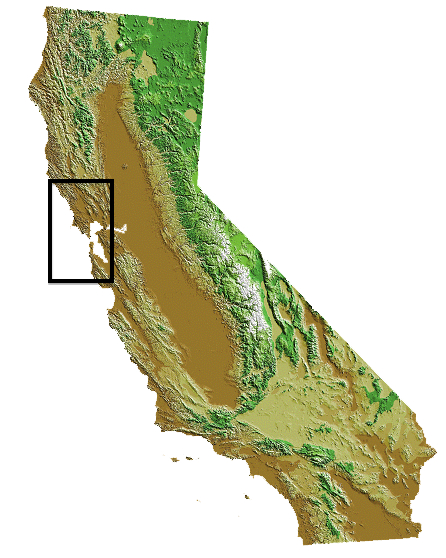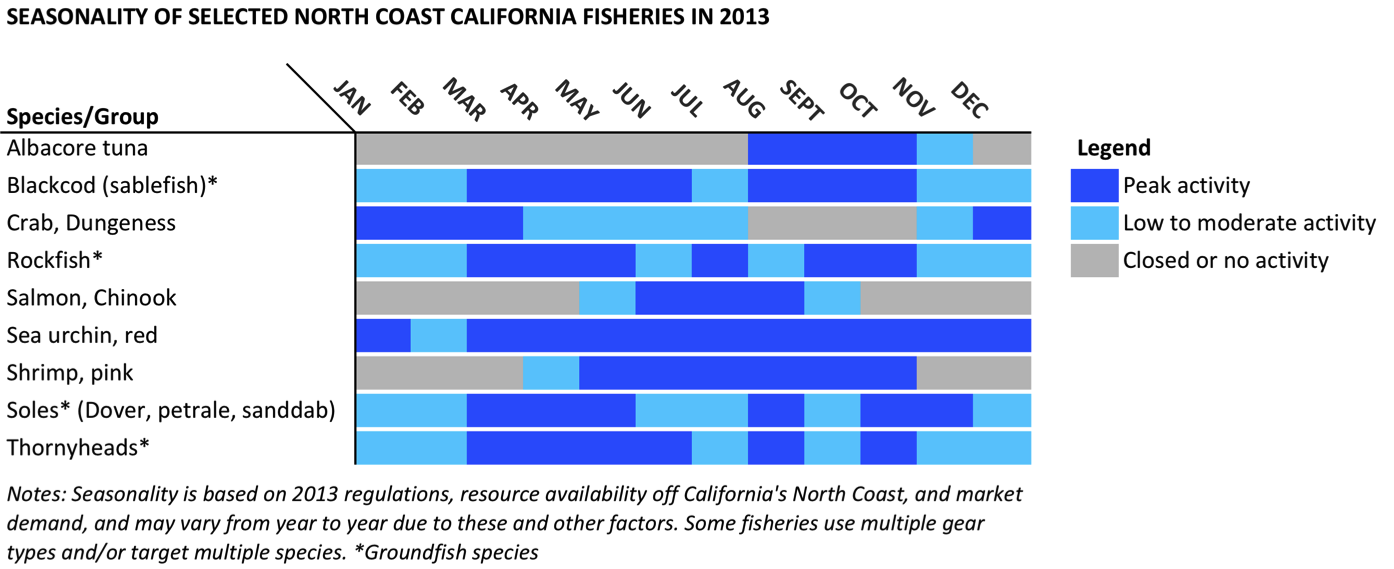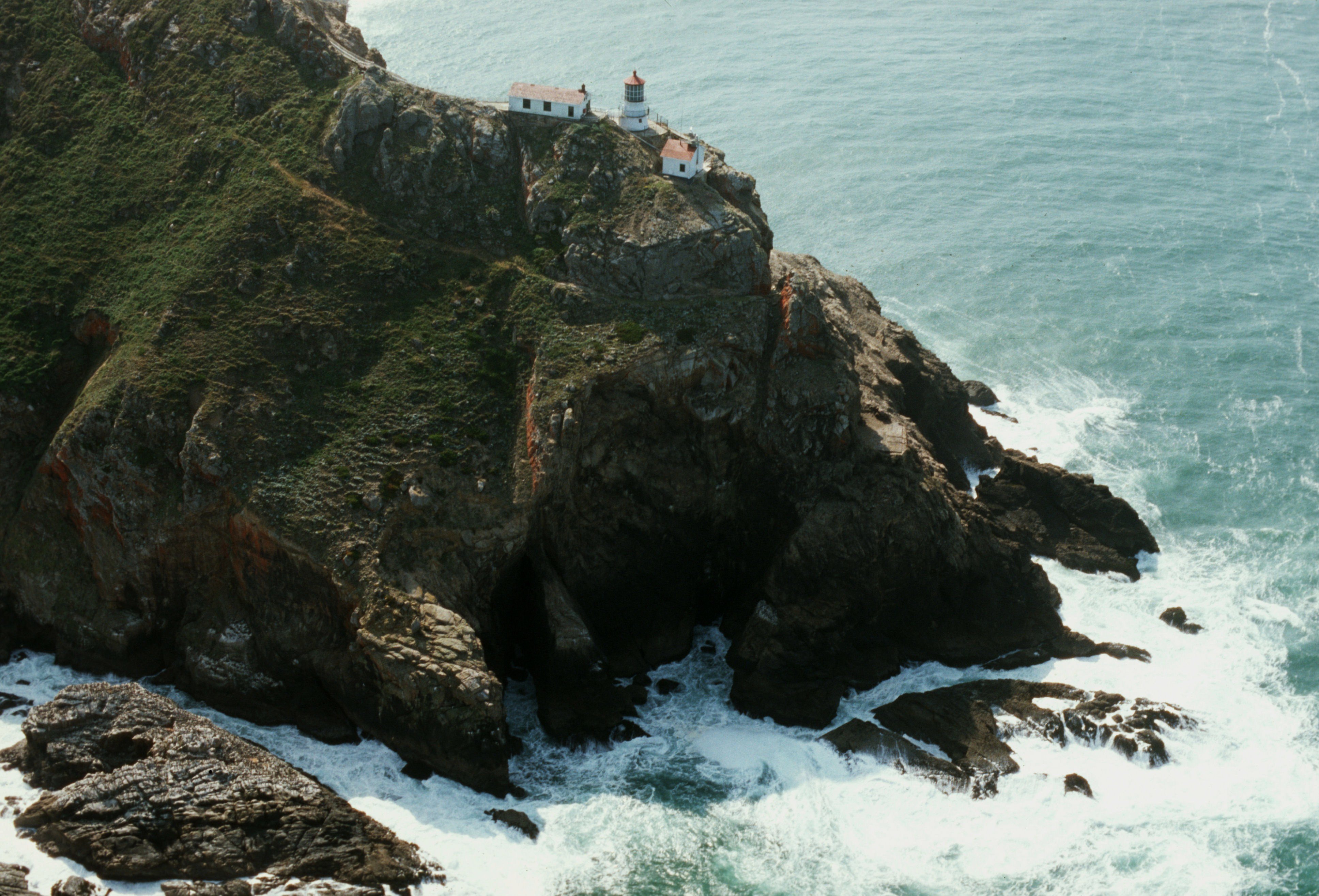
The North Central Coast region extends from south of Point Arena in southern Mendocino County to Half Moon Bay in San Mateo County, and includes San Francisco Bay. The more isolated fishing communities of Bodega Bay (Sonoma County) and Half Moon Bay (San Mateo County) are juxtaposed by the heavily populated, urban port communities of San Francisco Bay. Historically, San Francisco was the center of the booming salmon industry that came on the heels of the Gold Rush in the 1850s. Many seafood companies expanded from there, connecting transport routes with the North and Central Coast, supplying customers as far away as New York City via rail. Today's fishing in this region and throughout California is quite diverse, supplying local, regional and international markets.
Fishing communities
This region encompasses five counties with eleven primary port-based fishing communities (listed north to south):
| Sonoma County | Marin County | San Francisco County | Alameda County | San Mateo County |
| Bodega Bay | Bolinas | San Francisco | Alameda | Half Moon Bay |
| Point Reyes | Berkeley | |||
| Tomales Bay | Oakland | |||
| Sausalito | Richmond |
Types of commercial fisheries
Historically, this region has supported a variety of fisheries, with Dungeness crab, herring and salmon among the most active. However, the mix of fisheries and level of activity in each port and regionally varies as a function of changes in species distribution and availability, market demand, regulations, physical infrastructure, buyers and other factors.
In 2013, commercial fishermen landed more than 34.2 million pounds (15,563 metric tons) of seafood in this region with an ex-vessel value (amount paid to fishermen) of more than $51.5 million. The top fisheries (species-gear combinations; in alphabetical order) in terms of pounds landed and/or ex-vessel value included:
See our regional seafood posters and the California commercial landings data (links below) to learn more about the fisheries of this region.
| Ex-vessel Value (≥ $1 million each) | Pounds Landed (≥ 1 million pounds each) |
|---|---|
| California halibut hook-and-line, trawl | Dungess crab pot |
| Dungeness crab pot | Groundfish (flatfish, rockfish, roundfish, hook-and-line, trap, trawl) |
| Herring roe gillnet, kelp raft | Herring roe gillnet, kelp raft |
| Market squid seine | Market squid seine |
| Salmon (Chinook or king) troll | Salmon troll |
| Swordfish gillnet, harpoon |
Fisheries seasonality
The chart below shows the times when the major commercial fisheries of the North Central Coast region are most active. Other, smaller fisheries, while also important, are not shown here. This chart combines all gear types that target the indicated species. Note that fishing activity does not necessarily start at the beginning or stop at the end of a month, and that the timing and types of fisheries may vary from year to year. (See state and federal commercial fishing regulations for current and specific dates.)

The local ocean environment
The North Central Coast region is characterized by several unique geographical features that affect ocean conditions and weather and include:
- Bodega Head
- Point Arena and Point Reyes
- Farallon Islands
- San Francisco Bay
Several of these features are part of the region’s upwelling system, in which cold, nutrient-rich waters stream from Point Arena south to Point Reyes, Cordell Bank and the Farallon Islands. While much of the region’s seafloor habitat is soft (sand or mud) bottom, there also are rocky reefs, pinnacles, and outcrops. All of these features contribute to prime habitat (including rich feeding grounds) that support the region’s many and diverse fisheries.

Point Reyes, California. Credit: Common Murre Restoration Project, USFWS.
The management context
The region's commercial fisheries are managed by the state through the California Legislature, the Fish and Game Commission and the Department of Fish and Wildlife (CDFW); by the federal government through the Pacific Fishery Management Council (PFMC) and National Marine Fisheries Service (NMFS); or by both (see Management Context for more information). The following table shows which government entity (or entities) has management authority and the management measures used for some of the region’s most active fisheries.
| Fishery | Management Authority | Management Measures | |||||
|---|---|---|---|---|---|---|---|
| State | Federal | Limited Entry | Quotas | Time/area closures | Species size/sex rules | Gear restrictions | |
| Blackcod (sablefish) hook-and-line, trap, trawl | ✓ | ✓ | ✓ | ✓ | ✓ | ✓ | ✓ |
|
California halibut hook-and-line, set gillnet, trawl |
✓ | ✓ | ✓ | ✓ | ✓ | ||
| Dungeness crab pot | ✓ | ✓ | ✓ | ✓ | ✓ | ||
| Market squid seine | ✓ | ✓ | ✓ | ✓ | ✓ | ||
| Pacific herring gillnet | ✓ | ✓ | ✓ | ✓ | ✓ | ✓ | |
| Salmon troll | ✓ | ✓ | ✓ | ✓ | ✓ | ✓ | ✓ |
Note: Management authority and/or measures may vary for a given fishery depending on species and/or gear type.
Information sources
California Marine Life Protection Act Initiative (CA MLPAI). 2007. MLPAI Regional Profile of the North Central Coast Study Region (Alder Creek/Point Arena to Pigeon Point, California), October 8, 182 pp.
Largier, J. 2007. The Environment – Ocean Patterns: If We Knew the Hue of the Blue. Presentation to the California MLPA North Central Coast Regional Stakeholder Group. November 19, 2007.
Leet, W.S., Dewees, C.M., Klingbeil, R. and E.J. Larson. 2001. California's Living Marine Resources: A Status Report. 4th ed. Sacramento, CA: CDFG, 562 pp.
CDFW Commercial Landings Information
NMFS Commercial Fisheries Statistics
Pacific States Marine Fisheries Commission (PSMFC) Pacific Fisheries Information Network (PacFIN)
